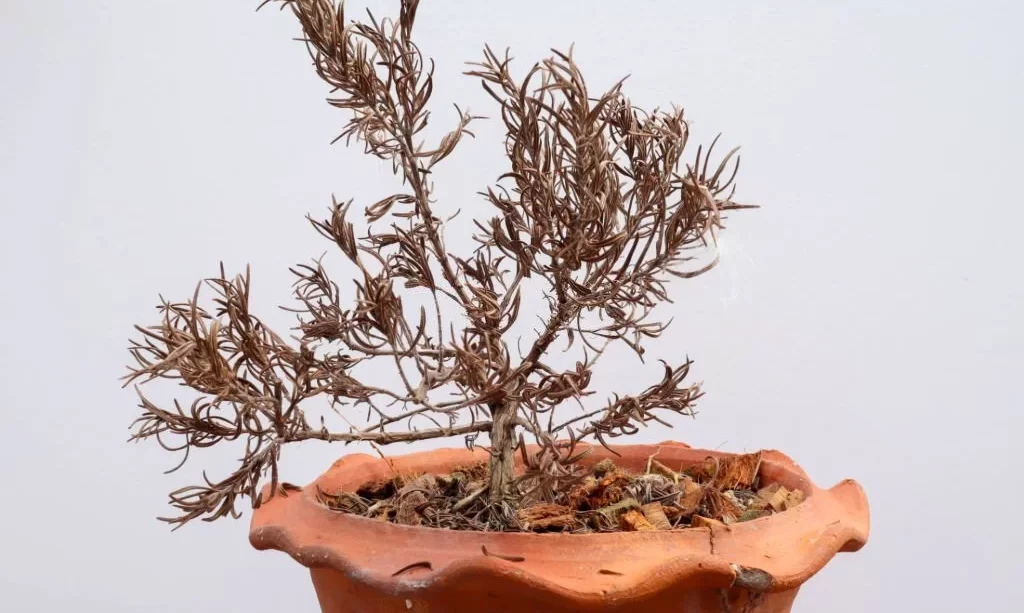Rosemary, with its fragrant leaves and aromatic presence, has long been cherished by gardeners, chefs, and herbal enthusiasts alike. This versatile herb not only adds flavor to culinary creations but also offers ornamental beauty to gardens and pots. However, like all living things, rosemary may face challenges that leave us wondering, “Is my rosemary dead”? In this article, we will explore the vitality of rosemary and guide you in determining the condition of your beloved herb. While rosemary is renowned for its resilience, it’s essential to recognize signs of distress and take appropriate steps to ensure its well-being. Let’s embark on this journey to discover the enduring nature of rosemary and how to care for it.
- STARTER HERBS: This four pack of Rosemary is a great start to your own rosemary field or in addition to your current garden!
- GROWTH: Rosemary can get up to 6ft tall and 4ft wide. The shrub has a moderate growth rate. It will reach its mature size and begin flowering in its second season.
- CARE: Rosemary prefers full sun, meaning at least six hours of direct sunlight on most days. Rosemary shrubs have good drought tolerance once they are mature, Allow the top few inches of soil to dry out between waterings.
- FUN FACT: Rosemary is a rich source of antioxidants and anti-inflammatory compounds, which are thought to help boost the immune system and improve blood circulation.
- LIVE PLANTS: Our plants are grown exclusively for Deep Roots and The Three Company, shipped fresh directly from our greenhouse to you!
The Resilience of Rosemary
Rosemary stands as a testament to nature’s ability to create robust and adaptable plant species. This herb, scientifically known as Rosmarinus officinalis, boasts several characteristics that contribute to its reputation for resilience:
- Drought Tolerance: Rosemary has evolved in regions with hot, arid climates, which has equipped it with exceptional drought tolerance. Its ability to thrive with minimal water makes it a survivor even in challenging conditions.
- Adaptability: Whether grown in the ground, in pots, or as part of a herb garden, rosemary exhibits remarkable adaptability to different environments. It can flourish in various soil types and sun exposure levels, making it a versatile addition to gardens.
- Hardiness: Rosemary is considered a hardy perennial in many regions, capable of withstanding mild frosts and chilly temperatures. In more temperate climates, it often retains its lush, evergreen foliage throughout the year.
These attributes make rosemary a resilient herb that can persevere through adverse circumstances, making it a favorite among gardeners and cooks. Despite its hardiness, rosemary may occasionally exhibit signs of stress or decline, prompting us to assess its condition and take appropriate action.
Signs of a Struggling Rosemary Plant
Recognizing the signs of a struggling rosemary plant is essential for its well-being. Here are some common indicators that your rosemary may be facing challenges:
- Wilted Foliage: When rosemary is in distress, its once-turgid, needle-like leaves may appear limp and droopy. This is often one of the first visual cues that something is amiss.
- Browning Leaves: If you notice the leaves turning brown or developing dark spots, it could be a sign of stress or disease. Healthy rosemary leaves should have a vibrant green hue.
- Loss of Aroma: Rosemary is prized for its aromatic foliage, and a reduction in its characteristic fragrance can indicate a decline in the plant’s health.
- Stunted Growth: A struggling rosemary plant may exhibit slowed growth or a lack of new growth. It may not thrive as it once did.
- Yellowing Foliage: Yellowing leaves can be a sign of nutrient deficiencies or improper watering practices. In healthy rosemary, leaves should remain predominantly green.
Assessing the Severity
Once you’ve identified signs of a struggling rosemary plant, it’s crucial to assess the severity of its condition. Not all issues are irreversible, and some may be temporary. Consider the following factors:
- Recent Stressors: Reflect on any recent changes in care, such as overwatering, underwatering, or exposure to extreme temperatures. Some issues may be resolved by addressing these stressors.
- Extent of Damage: Assess how widespread the signs of distress are. Is the entire plant affected, or are specific branches or leaves showing problems?
- Long-Term Health: Consider the overall health of the plant. A rosemary plant with a history of robust growth and good care is more likely to recover from temporary setbacks.
- Disease or Pests: Examine the plant closely for signs of diseases or pests. If infestations or infections are present, addressing these issues promptly is essential.
Steps to Revive a Struggling Rosemary Plant
If you determine that your rosemary is struggling but not beyond repair, you can take steps to revive it:
- Pruning: Trim away dead or damaged branches and leaves. Pruning promotes new growth and improves the plant’s overall appearance.
- Adjust Care: Ensure that your rosemary is receiving the right amount of water and sunlight. Rosemary prefers well-draining soil and moderate watering. Be cautious not to overwater, as this can lead to root rot.
- Repotting: If your rosemary has outgrown its container or if the soil has become compacted, consider repotting it into a slightly larger pot with fresh, well-draining soil.
- Fertilization: If your rosemary lacks vibrancy, consider fertilizing it with a balanced, water-soluble fertilizer formulated for herbs. Follow package instructions for application.
- Patience: Reviving a struggling rosemary plant may take time. Be patient and monitor its progress as you implement these care adjustments.
By taking these steps and closely monitoring your rosemary’s response, you can often rejuvenate a plant that has faced temporary challenges. However, in some cases, it may be necessary to accept that your rosemary plant has reached the end of its life cycle. In such instances, consider replanting or replacing it to continue enjoying the benefits of this wonderful herb.
- BENEFITS: Makes 6400 applications for house plants. (Makes 50 gallons; Each gallon makes 128 applications) It’s like a full ecosystem in a bottle that is a concentrated formula for watering your plants it’s easy: 1. 2. 3. and you’re ready to go. Great for all soil and growing media, hydroponics, semi-hydro, leca, vivarium with reptiles, terrariums, water gardens, fish tanks, flowers, and so much more. Good For Roots, Stems, Leaves, Blooms, Foliage, and overall plant health.
- WHAT IS IT? Fully Digested Elemental, Nutrient Supplement System for all plants. All vitamins and minerals with the microbial index are essential to a plant’s life. Complete Micro-fungi mycorrhizae and rhizobacteria strains in a pH Balanced formula.
- HOW LIQUI-DIRT IS MADE: Our Zymology process breaks down the 18 ingredients into thousands of separate, fully digested, and readily absorbable elements. This full nutrition can take over 5 years to complete before we bottle it up for you.
- WHATS IN IT: 18 Balanced Super Nutrients For Plants Including Poultry Litter, Rabbit Manure, Bat Guano, Cricket Fras, Humic Shale, Worm Castings, Oyster Shell, Mycorrhizae, Dolomite limes, Kelp Meal, Gypsum, Alfalfa meal, Concentrated Fulvic Acid, Blood meal, Proprietary mineral blend from the best sources.
- HOW LONG DOES IT LAST: This product does not expire in any dilution or concentrated form. Liqui-Dirt is made to dissolve immediately in the water you add to grow happy, healthy plants. Don’t be fooled by other liquids that promise and under deliver, Our full concentrate puts you in command of how much to use for each plant without concern of harming your plants.
When It’s Time to Say Goodbye
Despite our best efforts, there may come a time when we need to bid farewell to a beloved rosemary plant. Recognizing when it’s time to say goodbye is an essential part of responsible gardening:
- Persistent Decline: If your rosemary plant continues to deteriorate despite your efforts to revive it, it may be an indication that the issues it faces are insurmountable.
- Extensive Damage: When a significant portion of the plant is affected, it can be challenging to restore it to its former glory. Assess the overall health of the plant and consider whether it’s worth investing more time and resources.
- Disease or Pest Infestations: If your rosemary has fallen victim to a severe disease or pest infestation that threatens neighboring plants, it may be best to remove and dispose of the affected plant to prevent the issue from spreading.
- Age and Life Cycle: Rosemary plants have a natural life cycle, and as they age, they may become less productive and more susceptible to stressors. Recognizing when a rosemary plant has reached the end of its life cycle allows you to make room for a new, vigorous plant.
Replanting Rosemary
When the time comes to part ways with your struggling rosemary plant, consider the opportunity to replant or replace it:
- Selecting a Healthy Plant: If you choose to replant rosemary, select a healthy and vigorous specimen from a reputable nursery or garden center. Ensure that the plant has vibrant green foliage and shows no signs of disease or pests.
- Preparing the Soil: Prepare a well-draining soil mixture with compost or perlite to provide optimal conditions for your new rosemary plant. Rosemary thrives in soil that allows excess water to drain away.
- Caring for the New Herb: When planting your new rosemary, place it in an area with adequate sunlight and water it appropriately. Rosemary prefers moderate watering, allowing the soil to dry slightly between waterings.
- Consider a Fresh Start: Replanting or replacing your rosemary offers a fresh start. As you care for your new plant, apply the knowledge gained from your previous experience to ensure its health and vitality.
- Grows bigger, more bountiful plants (vs unfed plants)
- 100% organic mix
- For vegetables, fruits, flowers and herbs
- Pre-mixed blend
- Raised bed gardening improves drainage
Conclusion
In conclusion, rosemary, with its resilience and adaptability, is a remarkable herb that can thrive under various conditions. However, even the hardiest plants may face challenges that require careful consideration. Recognizing the signs of a struggling rosemary plant and assessing the severity of its condition are crucial steps in its care.
While taking steps to revive a struggling rosemary is often rewarding, there may be occasions when it’s best to let go and start anew. When saying goodbye to a declining rosemary, consider replanting or replacing it to continue enjoying the many culinary and ornamental benefits this herb offers.
As a gardener, your journey with rosemary is a dynamic one, marked by growth, learning, and adaptation. Whether you’re nurturing a thriving rosemary or beginning anew with a fresh plant, the enduring allure of this herb remains a delightful part of your gardening experience.






